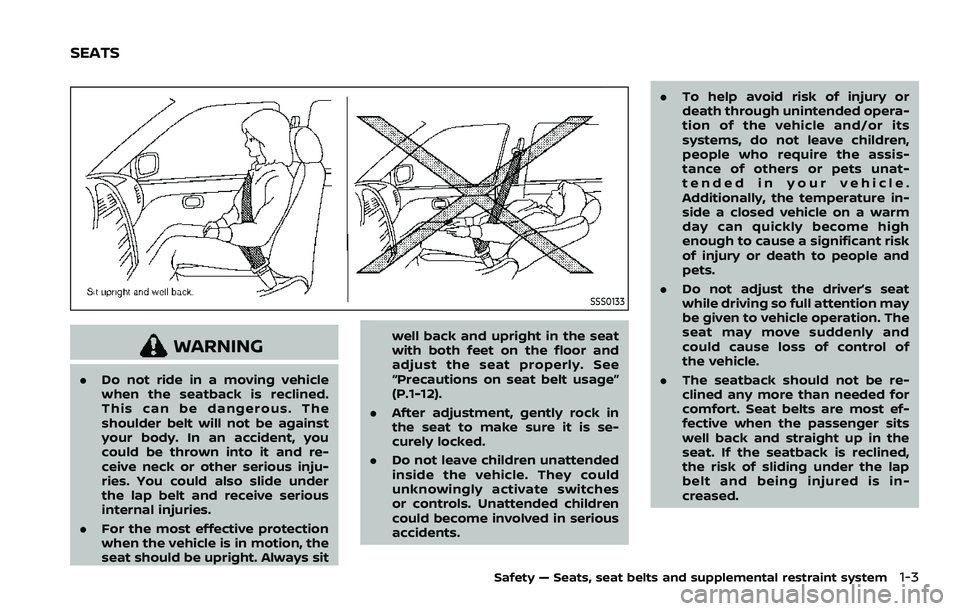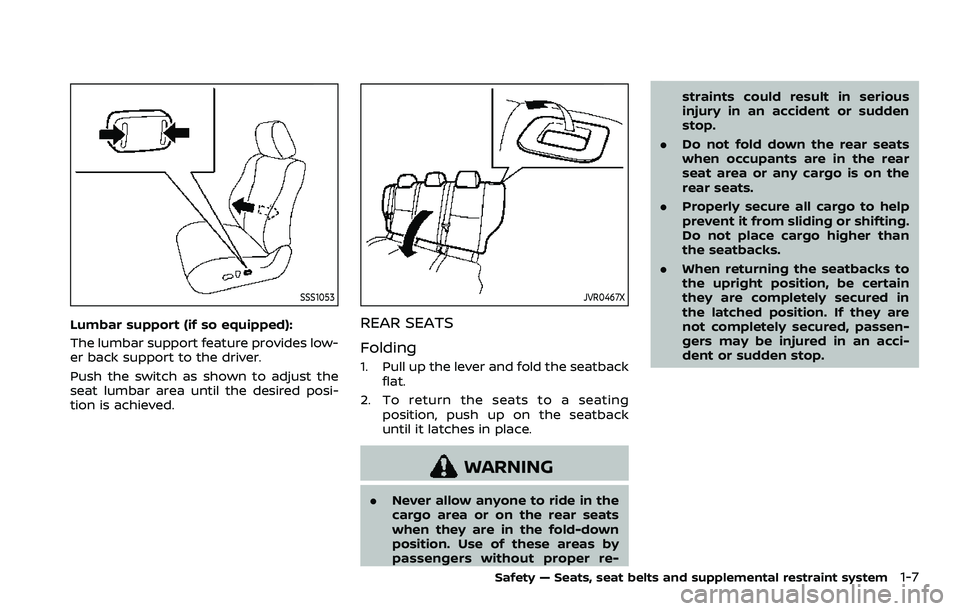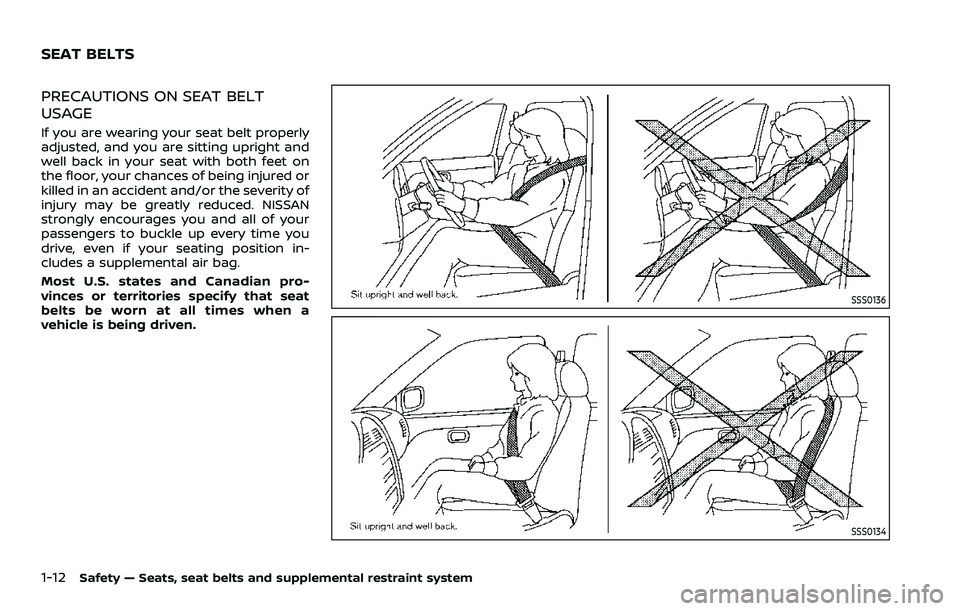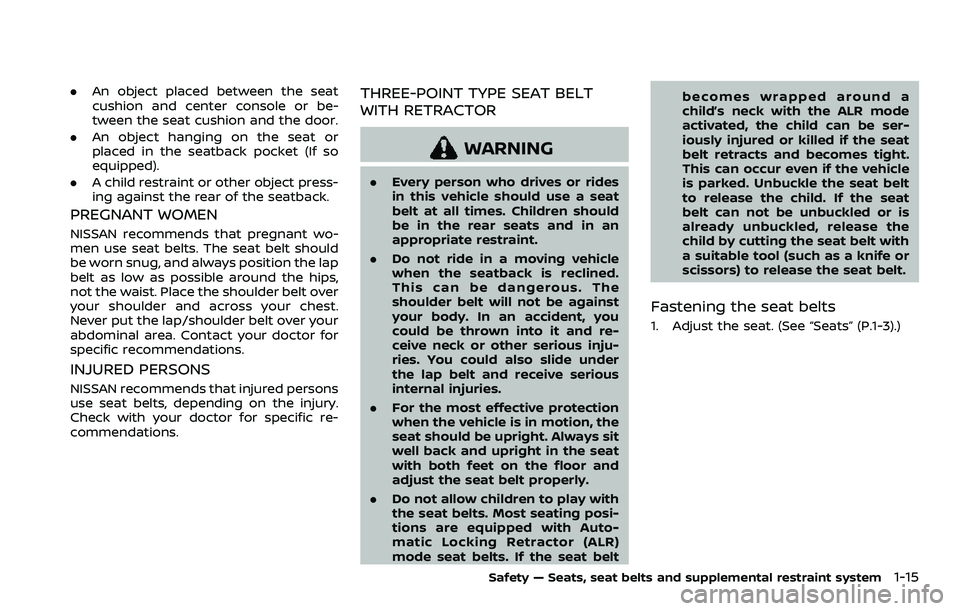2023 NISSAN QASHQAI Drive
[x] Cancel search: DrivePage 19 of 508

1 Safety — Seats, seat belts and supple-mental restraint system
Seats ........................................................................\
............................... 1-3
Front seats ........................................................................\
.......... 1-4
Rear seats ........................................................................\
............ 1-7
Armrest (if so equipped) ................................................... 1-8
Head restraints/headrests .................................................... 1-8 Adjustable head
restraint/headrest components ................................ 1-9
Non-adjustable head
restraint/headrest components ................................ 1-9
Remove ........................................................................\
............... 1-10
Install ........................................................................\
..................... 1-10
Adjust ........................................................................\
.................... 1-10
Seat belts ........................................................................\
................. 1-12
Precautions on seat belt usage .............................. 1-12
Seat belt warning light and chime ....................... 1-14
Pregnant women ................................................................ 1-15
Injured persons ..................................................................... 1-15
Three-point type seat belt with retractor ...... 1-15
Seat belt extenders ........................................................... 1-18
Seat belt maintenance ................................................... 1-18
Child safety ........................................................................\
............. 1-19 Infants ........................................................................\
.................. 1-19
Small children ........................................................................\
1-20
Larger children ...................................................................... 1-20 Child restraints ........................................................................\
... 1-21
Precautions on child restraints ............................. 1-22
Lower Anchors and Tethers for CHildren
(LATCH) system .................................................................. 1-24
Rear-facing child restraint installation
using LATCH ........................................................................\
. 1-27
Rear-facing child restraint installation
using the seat belts ........................................................ 1-29
Forward-facing child restraint installation
using LATCH ........................................................................\
. 1-31
Forward-facing child restraint installation
using the seat belts ........................................................ 1-34
Booster seats ....................................................................... 1-38
Supplemental Restraint System (SRS) ..................... 1-42 Precautions on SRS ........................................................ 1-42
NISSAN Advanced Air Bag System
(front seats) ........................................................................\
... 1-48
Driver and front passenger supplemental
knee air bag ........................................................................\
.. 1-57
Front and rear outboard seat-mounted
side-impact supplemental air bag and
roof-mounted curtain side-impact and
rollover supplemental air bag systems .......... 1-59
Seat belts with pretensioners (front and
rear outboard seats) ...................................................... 1-60
Page 21 of 508

SSS0133
WARNING
.Do not ride in a moving vehicle
when the seatback is reclined.
This can be dangerous. The
shoulder belt will not be against
your body. In an accident, you
could be thrown into it and re-
ceive neck or other serious inju-
ries. You could also slide under
the lap belt and receive serious
internal injuries.
. For the most effective protection
when the vehicle is in motion, the
seat should be upright. Always sit well back and upright in the seat
with both feet on the floor and
adjust the seat properly. See
“Precautions on seat belt usage”
(P.1-12).
. After adjustment, gently rock in
the seat to make sure it is se-
curely locked.
. Do not leave children unattended
inside the vehicle. They could
unknowingly activate switches
or controls. Unattended children
could become involved in serious
accidents. .
To help avoid risk of injury or
death through unintended opera-
tion of the vehicle and/or its
systems, do not leave children,
people who require the assis-
tance of others or pets unat-
tended in your vehicle.
Additionally, the temperature in-
side a closed vehicle on a warm
day can quickly become high
enough to cause a significant risk
of injury or death to people and
pets.
. Do not adjust the driver’s seat
while driving so full attention may
be given to vehicle operation. The
seat may move suddenly and
could cause loss of control of
the vehicle.
. The seatback should not be re-
clined any more than needed for
comfort. Seat belts are most ef-
fective when the passenger sits
well back and straight up in the
seat. If the seatback is reclined,
the risk of sliding under the lap
belt and being injured is in-
creased.
Safety — Seats, seat belts and supplemental restraint system1-3
SEATS
Page 25 of 508

SSS1053
Lumbar support (if so equipped):
The lumbar support feature provides low-
er back support to the driver.
Push the switch as shown to adjust the
seat lumbar area until the desired posi-
tion is achieved.
JVR0467X
REAR SEATS
Folding
1. Pull up the lever and fold the seatbackflat.
2. To return the seats to a seating position, push up on the seatback
until it latches in place.
WARNING
. Never allow anyone to ride in the
cargo area or on the rear seats
when they are in the fold-down
position. Use of these areas by
passengers without proper re- straints could result in serious
injury in an accident or sudden
stop.
. Do not fold down the rear seats
when occupants are in the rear
seat area or any cargo is on the
rear seats.
. Properly secure all cargo to help
prevent it from sliding or shifting.
Do not place cargo higher than
the seatbacks.
. When returning the seatbacks to
the upright position, be certain
they are completely secured in
the latched position. If they are
not completely secured, passen-
gers may be injured in an acci-
dent or sudden stop.
Safety — Seats, seat belts and supplemental restraint system1-7
Page 30 of 508

1-12Safety — Seats, seat belts and supplemental restraint system
PRECAUTIONS ON SEAT BELT
USAGE
If you are wearing your seat belt properly
adjusted, and you are sitting upright and
well back in your seat with both feet on
the floor, your chances of being injured or
killed in an accident and/or the severity of
injury may be greatly reduced. NISSAN
strongly encourages you and all of your
passengers to buckle up every time you
drive, even if your seating position in-
cludes a supplemental air bag.
Most U.S. states and Canadian pro-
vinces or territories specify that seat
belts be worn at all times when a
vehicle is being driven.
SSS0136
SSS0134
SEAT BELTS
Page 31 of 508

SSS0016
SSS0014
WARNING
.Every person who drives or rides
in this vehicle should use a seat
belt at all times. Children should
be properly restrained in the rear
seat and, if appropriate, in a child
restraint.
. The seat belt should be properly
adjusted to a snug fit. Failure to
do so may reduce the effective-
ness of the entire restraint sys-
tem and increase the chance or
severity of injury in an accident.
Serious injury or death can occur
if the seat belt is not worn prop-
erly.
. Always route the shoulder belt
over your shoulder and across
your chest. Never put the belt
behind your back, under your
arm or across your neck. The belt
should be away from your face
and neck, but not falling off your
shoulder.
. Position the lap belt as low and
snug as possible AROUND THE
HIPS, NOT THE WAIST. A lap belt
worn too high could increase the
risk of internal injuries in an
accident. .
Be sure the seat belt tongue is
securely fastened to the proper
buckle.
. Do not wear the seat belt inside
out or twisted. Doing so may
reduce its effectiveness.
. Do not allow more than one
person to use the same seat belt.
. Never carry more people in the
vehicle than there are seat belts.
. If the seat belt warning light
glows continuously while the
ignition is turned ON with all
doors closed and all seat belts
fastened, it may indicate a mal-
function in the system. Have the
system checked. It is recom-
mended you visit a NISSAN dealer
for this service.
. No changes should be made to
the seat belt system. For exam-
ple, do not modify the seat belt,
add material, or install devices
that may change the seat belt
routing or tension. Doing so may
affect the operation of the seat
belt system. Modifying or tam-
pering with the seat belt system
may result in serious personal
injury.
Safety — Seats, seat belts and supplemental restraint system1-13
Page 32 of 508

1-14Safety — Seats, seat belts and supplemental restraint system
.Once a seat belt pretensioner has
activated, it cannot be reused and
must be replaced together with
the retractor. It is recommended
you visit a NISSAN dealer for this
service.
. All seat belt assemblies, including
retractors and attaching hard-
ware, should be inspected after
any collision. It is recommended
you visit a NISSAN dealer for this
service. NISSAN recommends that
all seat belt assemblies in use
during a collision be replaced
unless the collision was minor
and the belts show no damage
and continue to operate properly.
Seat belt assemblies not in use
during a collision should also be
inspected and replaced if either
damage or improper operation is
noted.
. All child restraints and attaching
hardware should be inspected
after any collision. Always follow
the restraint manufacturer’s in-
spection instructions and repla-
cement recommendations. The
child restraints should be re-
placed if they are damaged.
JVR0575X
SEAT BELT WARNING LIGHT AND
CHIME
The driver and front passenger seats are
equipped with an enhanced seat belt
reminder function. If your vehicle is
equipped with an enhanced seat belt
reminder function, a visual and audible
alert will operate if a driver or front
passenger seat belt is unbuckled at
speeds of approximately 10 MPH (15
km/h) or more under the following con-
ditions:
.If the driver seat belt is not fastened.
. The front passenger’s seat belt is not
fastened and the seat is occupied by a
passenger for 7 seconds after the ignition switch is placed in the ON
position.
. The front passenger’s seat belt is not
fastened and objects or external force
on the passenger seat change the
seat belt reminder classification to
“occupied”.
The seat belt warning light will flash
under the conditions shown above until
the necessary seat belt is securely fas-
tened.
A warning chime will sound for approxi-
mately 95 seconds or until one of the
following conditions is met:
. The unbuckled front passenger’s seat
belt is securely fastened.
. The seat belt reminder function in the
front passenger seat no longer de-
tects that the front passenger seat is
occupied.
. The ignition switch is turned off.
The below situations could result in the
seat belt warning light being illuminated
and the chime sounding, even with no
occupant present in the passenger seat:
. Heavy objects placed on the seat.
. Someone pushing or pulling on the
front passenger seat.
. An object placed under the front
passenger seat.
Page 33 of 508

.An object placed between the seat
cushion and center console or be-
tween the seat cushion and the door.
. An object hanging on the seat or
placed in the seatback pocket (If so
equipped).
. A child restraint or other object press-
ing against the rear of the seatback.
PREGNANT WOMEN
NISSAN recommends that pregnant wo-
men use seat belts. The seat belt should
be worn snug, and always position the lap
belt as low as possible around the hips,
not the waist. Place the shoulder belt over
your shoulder and across your chest.
Never put the lap/shoulder belt over your
abdominal area. Contact your doctor for
specific recommendations.
INJURED PERSONS
NISSAN recommends that injured persons
use seat belts, depending on the injury.
Check with your doctor for specific re-
commendations.
THREE-POINT TYPE SEAT BELT
WITH RETRACTOR
WARNING
.Every person who drives or rides
in this vehicle should use a seat
belt at all times. Children should
be in the rear seats and in an
appropriate restraint.
. Do not ride in a moving vehicle
when the seatback is reclined.
This can be dangerous. The
shoulder belt will not be against
your body. In an accident, you
could be thrown into it and re-
ceive neck or other serious inju-
ries. You could also slide under
the lap belt and receive serious
internal injuries.
. For the most effective protection
when the vehicle is in motion, the
seat should be upright. Always sit
well back and upright in the seat
with both feet on the floor and
adjust the seat belt properly.
. Do not allow children to play with
the seat belts. Most seating posi-
tions are equipped with Auto-
matic Locking Retractor (ALR)
mode seat belts. If the seat belt becomes wrapped around a
child’s neck with the ALR mode
activated, the child can be ser-
iously injured or killed if the seat
belt retracts and becomes tight.
This can occur even if the vehicle
is parked. Unbuckle the seat belt
to release the child. If the seat
belt can not be unbuckled or is
already unbuckled, release the
child by cutting the seat belt with
a suitable tool (such as a knife or
scissors) to release the seat belt.
Fastening the seat belts
1. Adjust the seat. (See “Seats” (P.1-3).)
Safety — Seats, seat belts and supplemental restraint system1-15
Page 34 of 508

1-16Safety — Seats, seat belts and supplemental restraint system
JVR0572X
2. Slowly pull the seat belt out of theretractor and insert the tongue into
the buckle
until you hear and feel
the latch engage.
.The retractor is designed to lock
during a sudden stop or on im-
pact. A slow pulling motion per-
mits the belt to move and allows
you some freedom of movement
in the seat.
.If the seat belt cannot be pulledfrom its fully retracted position,
firmly pull the belt and release it.
Then smoothly pull the belt out of
the retractor.
JVR0573X
3. Position the lap belt portion low and
snug on the hipsas shown.
4. Pull the shoulder belt portion toward the retractor to take up extra slack
.
Be sure the shoulder belt is routed
over your shoulder and across your
chest.
The three-point seat belts in the front
passenger seat and the rear seating
positions have two modes of operation:
. Emergency Locking Retractor (ELR)
. Automatic Locking Retractor (ALR)
The Emergency Locking Retractor (ELR)
mode allows the seat belt to extend and
retract to allow the driver and passengers
some freedom of movement in the seat. The ELR locks the seat belt when the
vehicle slows down rapidly or during
certain impacts.
The Automatic Locking Retractor (ALR)
mode (child restraint mode) locks the
seat belt for child restraint installation.
When ALR mode is activated the seat belt
cannot be extended again until the seat
belt tongue is detached from the buckle
and fully retracted. The seat belt returns
to the ELR mode after the seat belt fully
retracts. For additional information, see
“Child restraints” (P.1-21).
The ALR mode should be used only for
child restraint installation. During nor-
mal seat belt use by an occupant, the
ALR mode should not be activated. If it
is activated, it may cause uncomforta-
ble seat belt tension.
WARNING
When fastening the seat belts, be
certain that seatbacks are comple-
tely secured in the latched position.
If they are not completely secured,
passengers may be injured in an
accident or sudden stop.